Vegan Basil Pesto
This simple plant-based pesto recipe uses Samin Nosrat’s hybrid method for traditional Ligurian pesto. The delicious vegan pesto is a great way to use up summer’s abundance of fresh basil. Add the versatile basil pesto sauce to pasta, salads and pizza.
This simple vegan pesto sauce is like a cross between traditional Genoese pesto and a French pistou. It is a versatile condiment that turns any salad or pasta dish into a delicious and satisfying meal.
As a bonus, this dairy-free pesto sauce freezes exceptionally well. And it’s a great way to use up large amounts of fresh basil leaves while they are abundant in summer.
Homemade basil pesto trumps store-bought pesto every time. And with this easy dairy-free pesto recipe, you have no excuse not to give it a try!
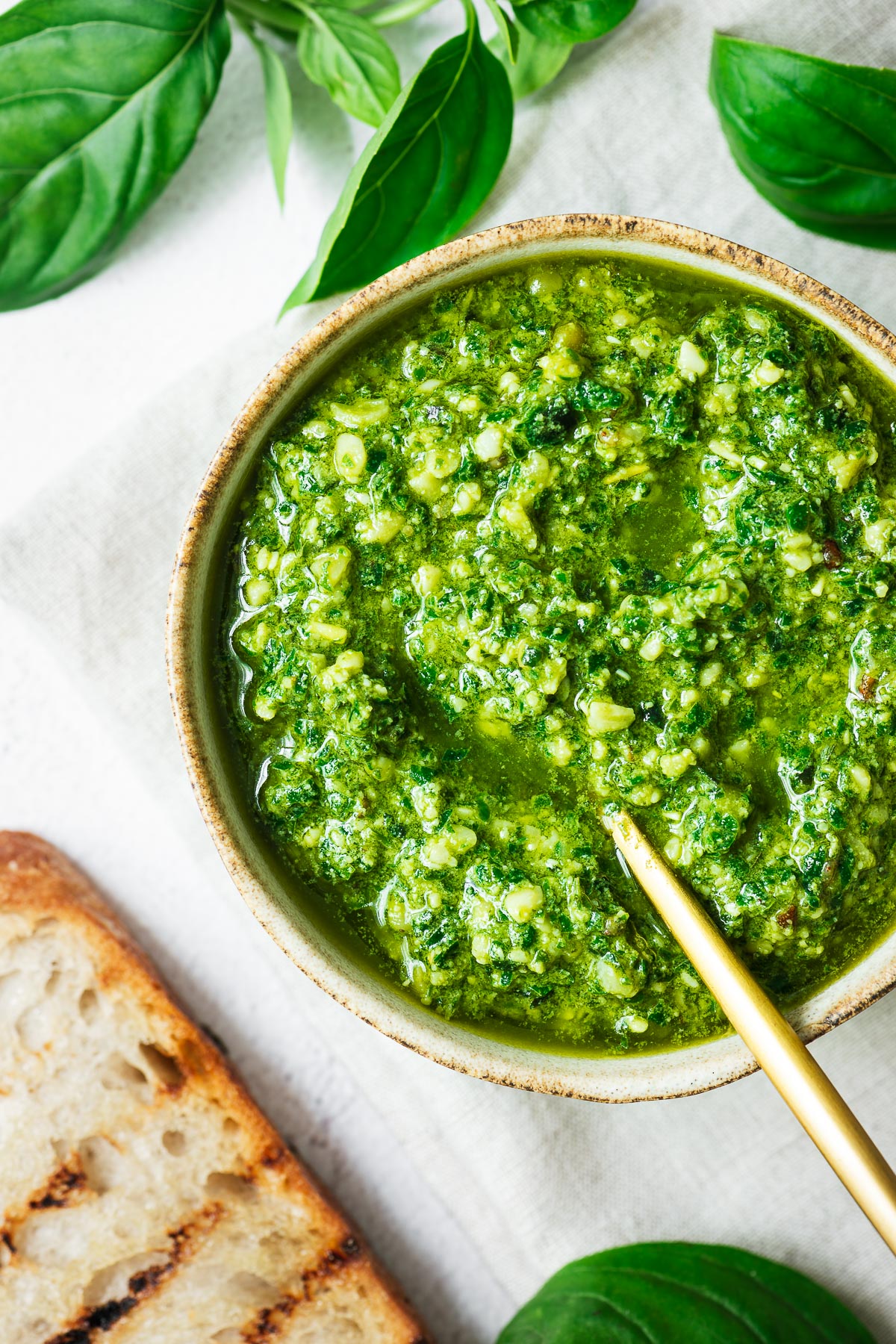
What is pesto?
Pesto Alla Genovese (Genoese pesto) is the original Italian pesto from Genoa, the capital of Liguria, Italy. It is a gorgeous green condiment made from a few good quality, fresh ingredients, Italian-style.
Traditional pesto recipes contain crushed garlic, European pine nuts, coarse sea salt, basil leaves, and hard cheese like Parmigiano-Reggiano (Parmesan cheese) or Pecorino, all blended with olive oil.
French pistou is a cold sauce with garlic, fresh basil and olive oil. It is similar to a nut-free, dairy-free pesto sauce.
This delicious vegan pesto recipe lies somewhere in between these traditional sauces.
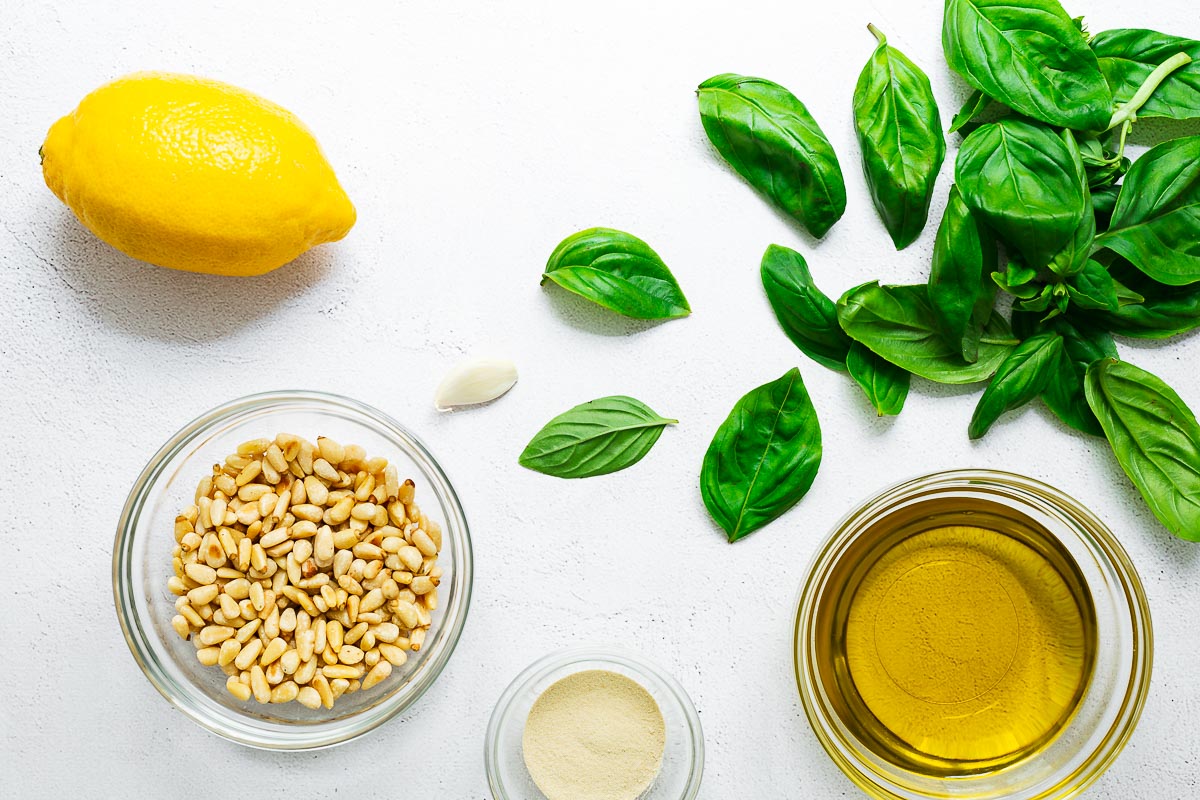
Plant-based pesto ingredients & substitutions
Parmesan cheese is the only source of acidity in traditional pesto. To turn traditional pesto vegan, you should replace the acidity. It is why I add a squeeze of lemon juice.
And for the umami cheese flavour, you can add nutritional yeast. But I’m equally happy to omit it.
- Basil: Fresh basil leaves are the main ingredient in this vegan version of traditional basil pesto. But you can make pesto from other fresh herbs or leafy greens, like arugula or kale.
- Pine nuts: Don’t skimp on your nuts when making this dairy-free version. It creates a creamy texture and nutty flavour that balances the fresh, green basil flavour. Read more about the best substitute for pine nuts in pesto if you prefer not to use them.
- Olive oil: Use good quality extra virgin olive oil. It is a big part of the Italian flavour profile in this delicious pesto.
- Garlic cloves: While I sometimes suggest shop-bought minced garlic as a substitute, this is not one of those days. Use fresh garlic cloves in cold sauces like pesto. Or substitute with roasted garlic or, in a pinch, try half a teaspoon of garlic powder.
- Lemon juice: Pesto is a balance of the herbaceous basil flavour, fat, salt and acidity (traditionally from cheese). I prefer a squeeze of fresh lemon juice, but you can use a splash of apple cider vinegar if that is what you have.
- Nutritional yeast: Use nutritional yeast flakes or powder for a cheesy flavour and a protein boost. But this is optional. The vibrant pesto is utterly delicious, with or without the nutritional yeast.
Related post: Best substitute for pine nuts in pesto
How to make vegan basil pesto
It is hardly news that pounding basil pesto in a mortar and pestle yields the best results. In Italian, the word pesto means “pounded”. And traditional pesto is made in an, often really large, mortar and pestle.
But, in the interest of time and sanity, I adapt Samin Nosrat’s hybrid method from her classic pesto recipe in Salt, Fat, Acid, Heat.
Step 1: Pound garlic and pine nuts into a paste
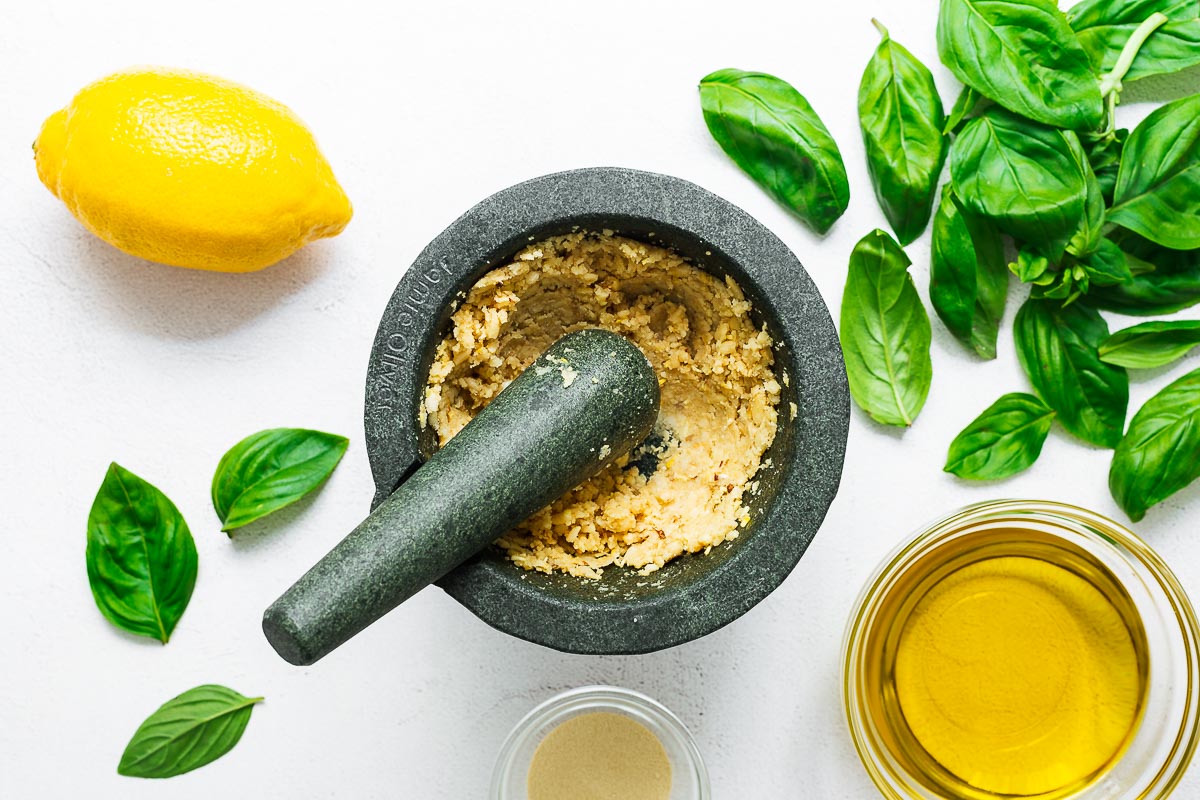
Place the roughly chopped garlic clove in a mortar with half a teaspoon of salt. Coarse sea salt works best, but you can also use kosher salt.
Grind the garlic into a paste with the pestle.
Then add the toasted pine nuts and bash them into a paste. It will be a thick paste with a creamy texture. Don’t worry if there are still a few pieces of nuts visible.
You can skip this step and add the garlic and nuts to the food processor before the basil leaves.
Step 2: Process the fresh basil leaves
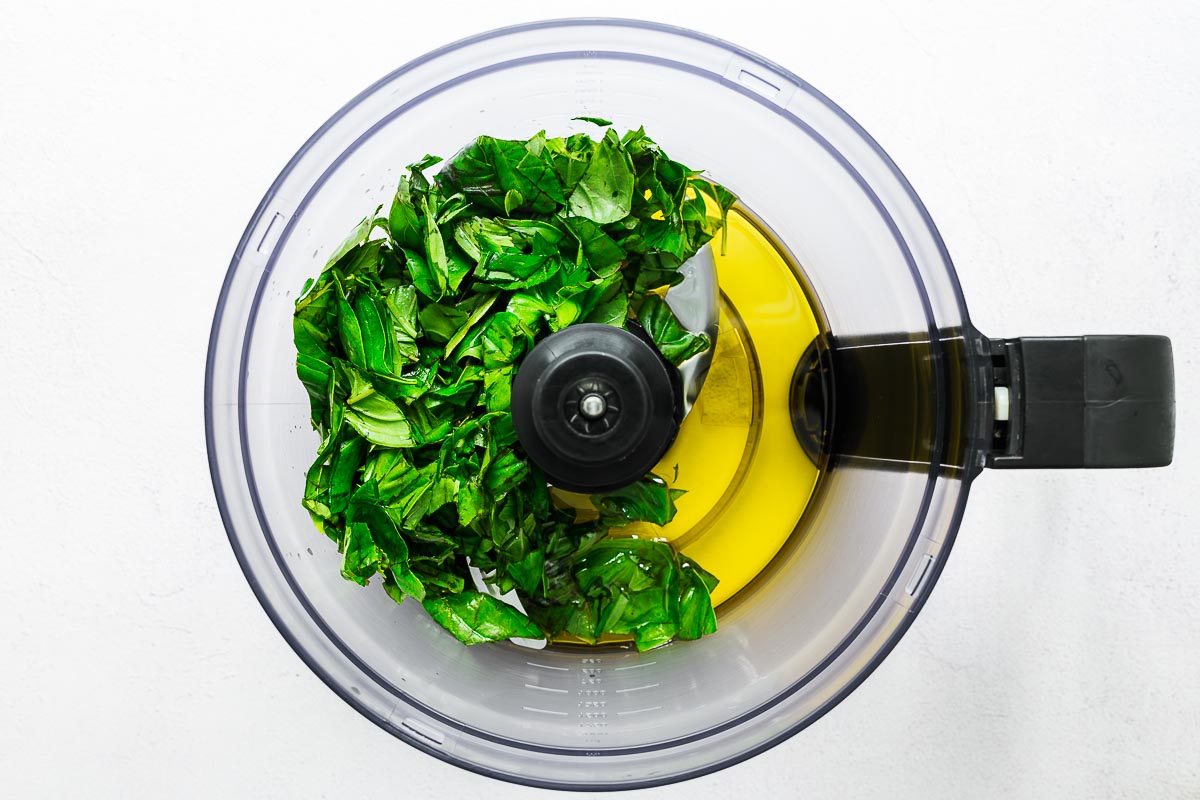
The key to making pesto in a food processor is to avoid over-processing. The heat generated by the motor, along with oxidation from over-chopping, can cause the basil to turn brown.
Pour half the olive oil into the blender or food processor bowl to encourage the basil to break down quickly.
And, to avoid over-processing, roughly chop the basil leaves with a knife, and add them to the olive oil.
Pulse the basil leaves in the food processor. Stop to push down the leaves with a spatula a couple of times. And keep going until you have a coarse, emerald-green basil paste. It should take a minute or so.
Step 3: Mix the basil pesto
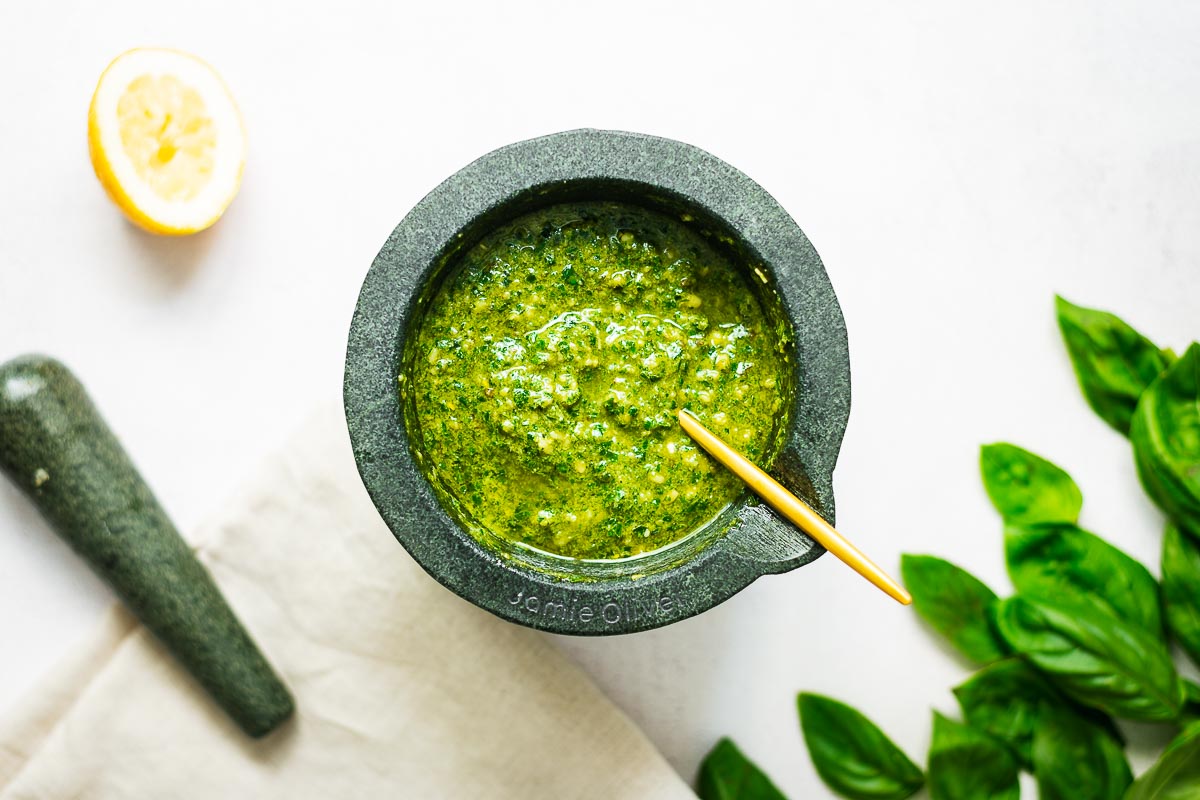
Transfer the basil paste to a bowl, stir through the remaining olive oil and add the salty garlic and pine nut paste.
Mix in the lemon juice and nutritional yeast (if using).
Taste and adjust the salt and acidity. Keep in mind that the flavours develop as the mixture sits.
Transfer the pesto to an airtight container or glass jar and cover it with a thin layer of olive oil. You can store pesto in the fridge for three to four days.
How to freeze pesto with fresh basil
You can place pesto in a freezer-proof airtight container and freeze it for up to three months.
But, I prefer to freeze the pesto in ice cube trays. It also works great for small amounts of leftover pesto.
Transfer the pesto to an ice cube tray and freeze it until solid. Then transfer the pesto cubes to a freezer bag (reusable silicone or Ziploc bag). Squeeze as much air as possible from the freezer bag.
Defrost your pesto cubes as needed.
When I make a large batch of basil pesto for freezing, I leave the lemon juice and the nutritional yeast. Then, when I defrost the pesto, I add fresh lemon juice, more olive oil and nutritional yeast to taste.
Serving suggestion
Pesto is a versatile condiment. It’s a great sauce to make in the summer months when fresh basil is available in abundance.
Serve basil pesto as pasta sauce:
Add your green pesto to a large bowl and toss it with cooked, drained pasta for a vegan pesto pasta dinner. Thin with pasta cooking water if needed, drizzle with olive oil and garnish with fresh basil leaves.
Don’t heat pesto sauce, or the colour will dull.
Use as a salad dressing:
Pesto is a delicious salad dressing. Mix it with olive oil and lemon juice to taste and drizzle over chopped salads.
Or mix pesto with sliced heirloom tomatoes for a quick-and-easy tomato pesto salad.
Basil pesto is also delicious in potato salad. Skip the chopped herbs and add a quarter cup of fresh pesto to this vegan herbed potato salad.
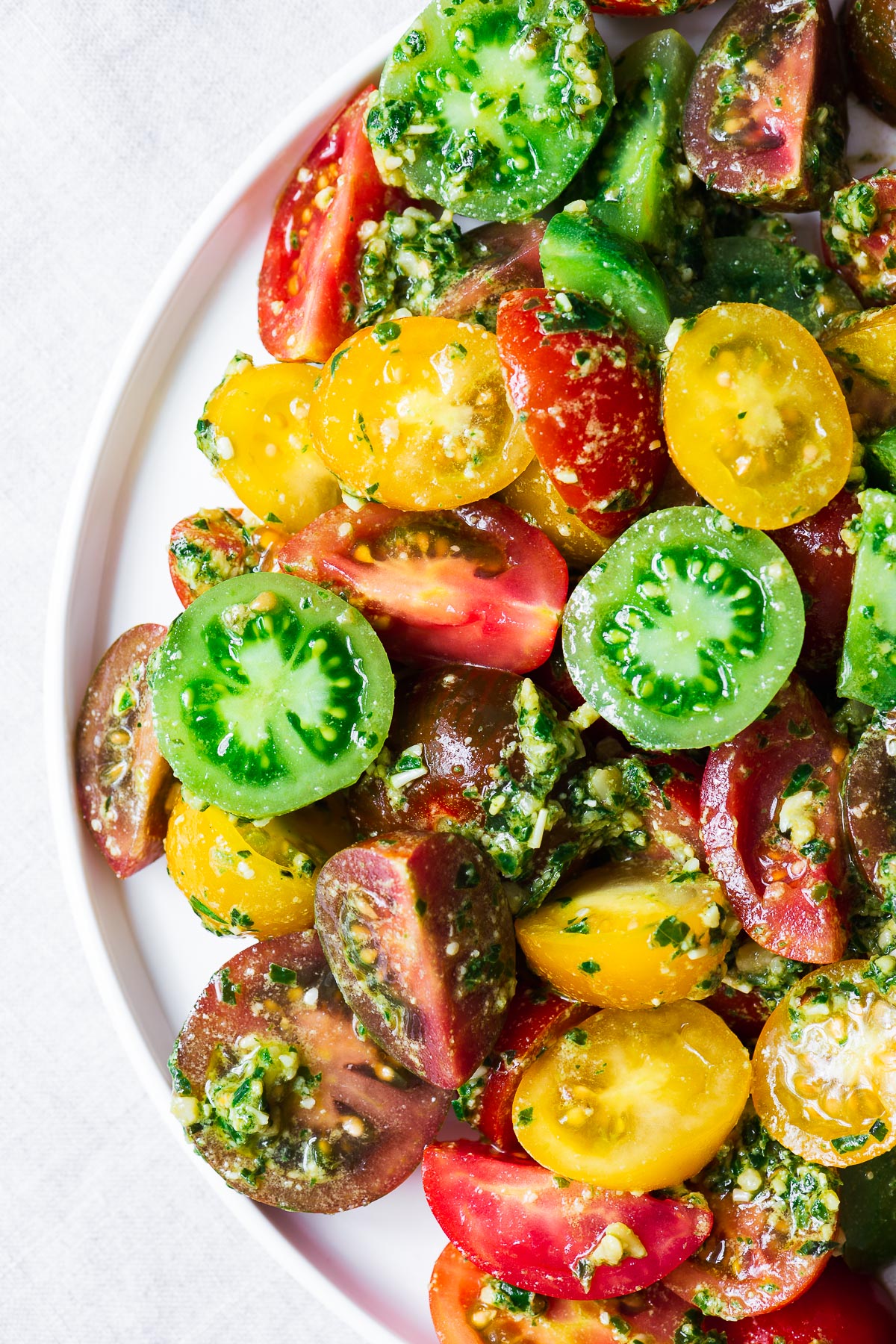
Add it to toast:
Drizzle pesto over your avo toast. Or serve your pesto with focaccia or soft, crusty white bread to scoop up the green sauce.
For pesto pizza, drizzle homemade pesto over cooked pizza. Don’t heat the pesto.
Serve pesto with soup:
Drizzle pesto over any soup in need of a fresh flavour boost.
Try it with:
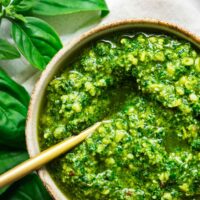
Equipment
Ingredients
- 1 garlic clove, roughly chopped
- ½ teaspoon salt, more to taste
- ½ cup pine nuts, lightly toasted*
- ½ cup extra virgin olive oil, more to top
- 2 packed cups fresh basil leaves, roughly chopped
- 1 tablespoon lemon juice
- 1 tablespoon nutritional yeast (optional)
Instructions
- Place the roughly chopped garlic clove in a mortar with half a teaspoon of salt. Grind the garlic into a paste. Then add the toasted pine nuts and bash into a creamy paste.
- Pour half the olive oil into the blender or food processor bowl. Then add the chopped basil leaves and pulse, stopping to push down the leaves with a spatula a couple of times until you have a fragrant, emerald-green basil paste.
- Transfer the basil paste to a bowl with the remaining olive oil, and add the salty garlic and pine nut paste. Mix in the lemon juice and nutritional yeast (if using).
- Taste and adjust the salt and acidity. Keep in mind that the flavours develop as the mixture sits.
Notes
- Toast raw pine nuts in a hot, dry pan for a few seconds – taking care not to burn them. Or use pine nuts raw.
- If you’re not in the mood to bash the garlic and nuts separately with a mortar and pestle, you can add them to the food processor before you add the fresh basil.
- When I plan to freeze basil, I don’t add lemon juice or nutritional yeast. I add it when I defrost the basil pesto to revive it a bit.
- See ingredients and substitutes and how to make vegan pesto for more details.
Try more delicious vegan green sauces and dips:
